

Compact Muon Solenoid
LHC, CERN
| CMS-SUS-14-005 ; CERN-PH-EP-2015-213 | ||
| Search for supersymmetry in the vector-boson fusion topology in proton-proton collisions at $\sqrt{s} = $ 8 TeV | ||
| CMS Collaboration | ||
| 30 August 2015 | ||
| J. High Energy Phys. 11 (2015) 189 | ||
| Abstract: The first search for supersymmetry in the vector-boson fusion topology is presented. The search targets final states with at least two leptons, large missing transverse momentum, and two jets with a large separation in rapidity. The data sample corresponds to an integrated luminosity of 19.7 fb$^{-1}$ of proton-proton collisions at $\sqrt{s} = $ 8 TeV collected with the CMS detector at the CERN LHC. The observed dijet invariant mass spectrum is found to be consistent with the expected standard model prediction. Upper limits are set on the cross sections for chargino and neutralino production with two associated jets, assuming the supersymmetric partner of the $\tau$ lepton to be the lightest slepton and the lightest slepton to be lighter than the charginos. For a so-called compressed-mass-spectrum scenario in which the mass difference between the lightest supersymmetric particle $\tilde{\chi}^0_1$ and the next lightest, mass-degenerate, gaugino particles $\tilde{ \chi }_2^0$ and $\tilde{ \chi }^{\pm}_1$ is 50 GeV, a mass lower limit of 170 GeV is set for these latter two particles. | ||
| Links: e-print arXiv:1508.07628 [hep-ex] (PDF) ; CDS record ; inSPIRE record ; CADI line (restricted) ; | ||
| Figures | |
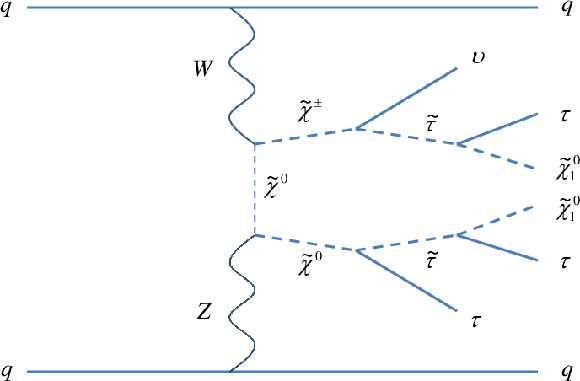
png pdf |
Figure 1-a:
Diagrams of (a) chargino-neutralino and (b) chargino-chargino pair production through vector-boson fusion followed by their decays to leptons and the LSP $\tilde{\chi}^0_1 $. |

png pdf |
Figure 1-b:
Diagrams of (a) chargino-neutralino and (b) chargino-chargino pair production through vector-boson fusion followed by their decays to leptons and the LSP $\tilde{\chi}^0_1 $. |

png pdf |
Figure 2:
The VBF efficiency as a function of jet pair mass $m_{jj}$ measured for the ${\mathrm{ t \bar{t} } }$ and Z+jets control regions of the $\mu \mu jj$ final state, for the ``Loose" ($ {p_{\mathrm {T}}} >$ 30 GeV ) and ``Tight" ($ {p_{\mathrm {T}}} > $ 50 GeV ) event selections. |
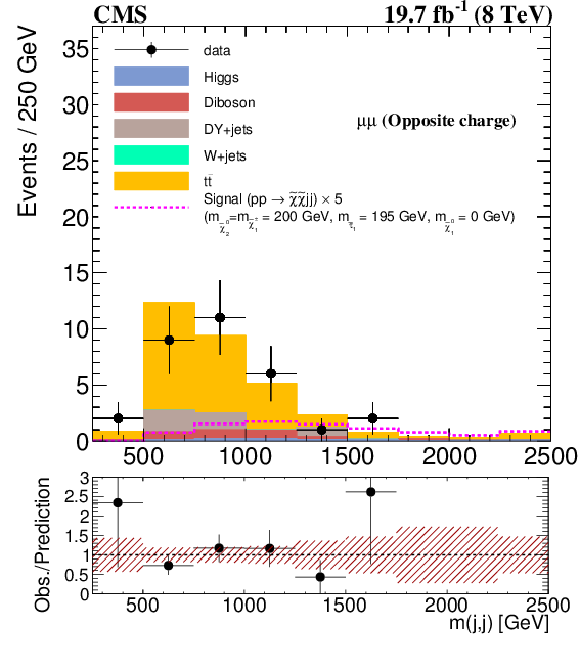
png pdf |
Figure 3-a:
Dijet invariant mass distributions in the (a) OS $\mu \mu $, (b) SS $\mu \mu $, (c) OS $\mathrm{ e } \mu $, and (d) SS e$\mu $ signal regions. The signal scenario with $m_{\tilde{ \chi }_2^0 }=m_{\tilde{ \chi }^{\pm}_1 }= $ 200 GeV , $m_{\tilde{ \tau }} = $ 195 GeV , and $m_{\tilde{\chi}^0_1 }= $ 0 GeV , as described in Section 4, is shown. The signal events are scaled up by a factor of 5 for purposes of visibility. The shaded band in the ratio plot includes the systematic and statistical uncertainties in the background prediction. |
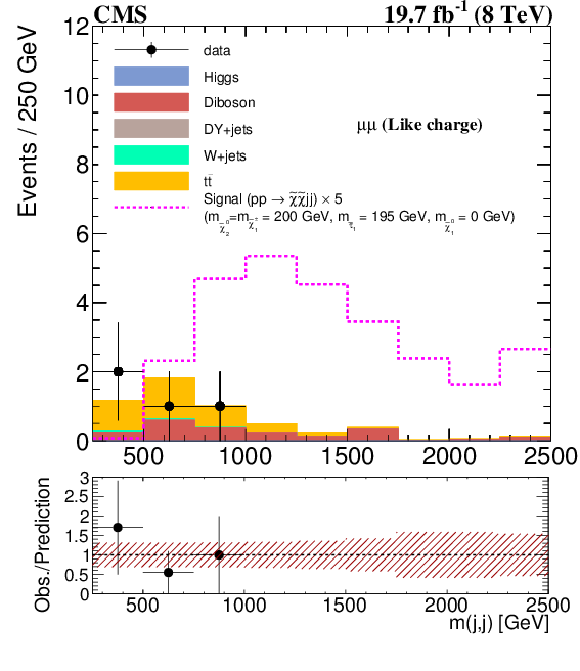
png pdf |
Figure 3-b:
Dijet invariant mass distributions in the (a) OS $\mu \mu $, (b) SS $\mu \mu $, (c) OS $\mathrm{ e } \mu $, and (d) SS e$\mu $ signal regions. The signal scenario with $m_{\tilde{ \chi }_2^0 }=m_{\tilde{ \chi }^{\pm}_1 }= $ 200 GeV , $m_{\tilde{ \tau }} = $ 195 GeV , and $m_{\tilde{\chi}^0_1 }= $ 0 GeV , as described in Section 4, is shown. The signal events are scaled up by a factor of 5 for purposes of visibility. The shaded band in the ratio plot includes the systematic and statistical uncertainties in the background prediction. |

png pdf |
Figure 3-c:
Dijet invariant mass distributions in the (a) OS $\mu \mu $, (b) SS $\mu \mu $, (c) OS $\mathrm{ e } \mu $, and (d) SS e$\mu $ signal regions. The signal scenario with $m_{\tilde{ \chi }_2^0 }=m_{\tilde{ \chi }^{\pm}_1 }= $ 200 GeV , $m_{\tilde{ \tau }} = $ 195 GeV , and $m_{\tilde{\chi}^0_1 }= $ 0 GeV , as described in Section 4, is shown. The signal events are scaled up by a factor of 5 for purposes of visibility. The shaded band in the ratio plot includes the systematic and statistical uncertainties in the background prediction. |
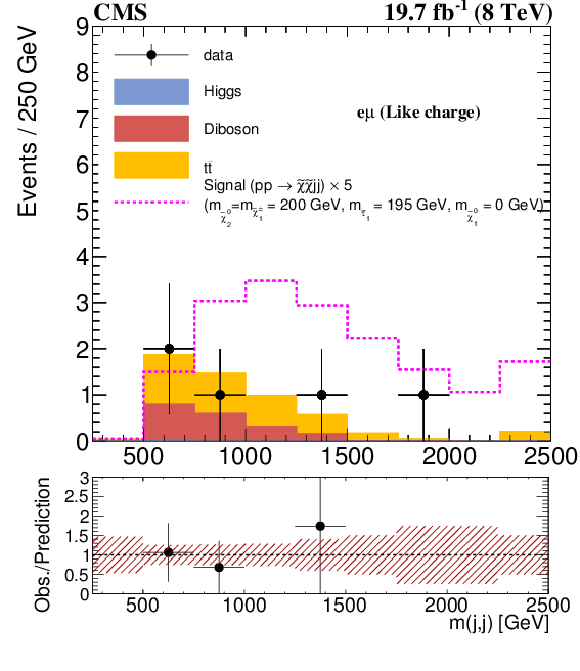
png pdf |
Figure 3-d:
Dijet invariant mass distributions in the (a) OS $\mu \mu $, (b) SS $\mu \mu $, (c) OS $\mathrm{ e } \mu $, and (d) SS e$\mu $ signal regions. The signal scenario with $m_{\tilde{ \chi }_2^0 }=m_{\tilde{ \chi }^{\pm}_1 }= $ 200 GeV , $m_{\tilde{ \tau }} = $ 195 GeV , and $m_{\tilde{\chi}^0_1 }= $ 0 GeV , as described in Section 4, is shown. The signal events are scaled up by a factor of 5 for purposes of visibility. The shaded band in the ratio plot includes the systematic and statistical uncertainties in the background prediction. |
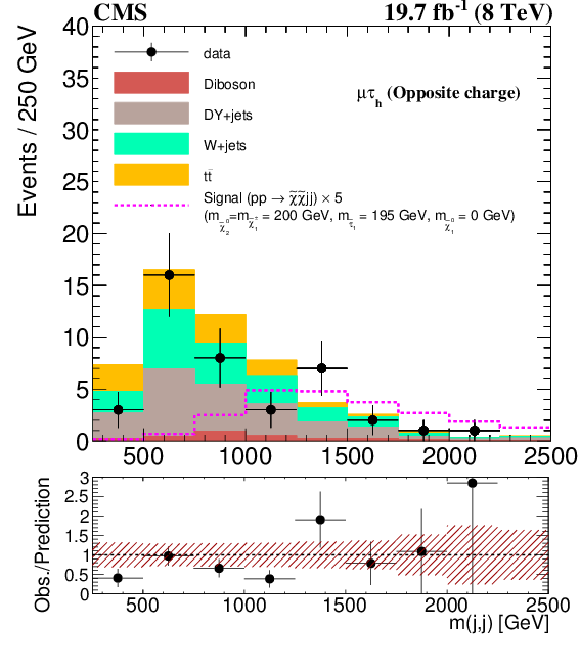
png pdf |
Figure 4-a:
Dijet invariant mass distributions in the (a) OS $\mu \tau _{ {\tau _\mathrm {h}} }$, (b) SS $\mu \tau _{ {\tau _\mathrm {h}} }$, (c) OS $\tau _{ {\tau _\mathrm {h}} }\tau _{ {\tau _\mathrm {h}} }$, and (d) SS $\tau _{ {\tau _\mathrm {h}} }\tau _{ {\tau _\mathrm {h}} }$ signal regions. The signal scenario with $m_{\tilde{ \chi }_2^0 }=m_{\tilde{ \chi }^{\pm}_1 }= $ 200 GeV , $m_{\tilde{ \tau }} = $ 195 GeV , and $m_{\tilde{\chi}^0_1 }= $ 0 GeV , as described in Section 4, is shown. The signal events are scaled up by a factor of 5 for purposes of visibility. The shaded band in the ratio plot includes the systematic and statistical uncertainties in the background prediction. |

png pdf |
Figure 4-b:
Dijet invariant mass distributions in the (a) OS $\mu \tau _{ {\tau _\mathrm {h}} }$, (b) SS $\mu \tau _{ {\tau _\mathrm {h}} }$, (c) OS $\tau _{ {\tau _\mathrm {h}} }\tau _{ {\tau _\mathrm {h}} }$, and (d) SS $\tau _{ {\tau _\mathrm {h}} }\tau _{ {\tau _\mathrm {h}} }$ signal regions. The signal scenario with $m_{\tilde{ \chi }_2^0 }=m_{\tilde{ \chi }^{\pm}_1 }= $ 200 GeV , $m_{\tilde{ \tau }} = $ 195 GeV , and $m_{\tilde{\chi}^0_1 }= $ 0 GeV , as described in Section 4, is shown. The signal events are scaled up by a factor of 5 for purposes of visibility. The shaded band in the ratio plot includes the systematic and statistical uncertainties in the background prediction. |
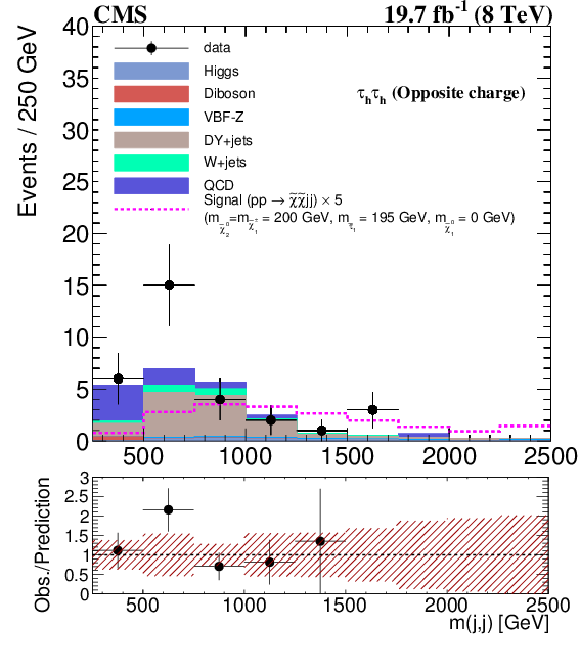
png pdf |
Figure 4-c:
Dijet invariant mass distributions in the (a) OS $\mu \tau _{ {\tau _\mathrm {h}} }$, (b) SS $\mu \tau _{ {\tau _\mathrm {h}} }$, (c) OS $\tau _{ {\tau _\mathrm {h}} }\tau _{ {\tau _\mathrm {h}} }$, and (d) SS $\tau _{ {\tau _\mathrm {h}} }\tau _{ {\tau _\mathrm {h}} }$ signal regions. The signal scenario with $m_{\tilde{ \chi }_2^0 }=m_{\tilde{ \chi }^{\pm}_1 }= $ 200 GeV , $m_{\tilde{ \tau }} = $ 195 GeV , and $m_{\tilde{\chi}^0_1 }= $ 0 GeV , as described in Section 4, is shown. The signal events are scaled up by a factor of 5 for purposes of visibility. The shaded band in the ratio plot includes the systematic and statistical uncertainties in the background prediction. |
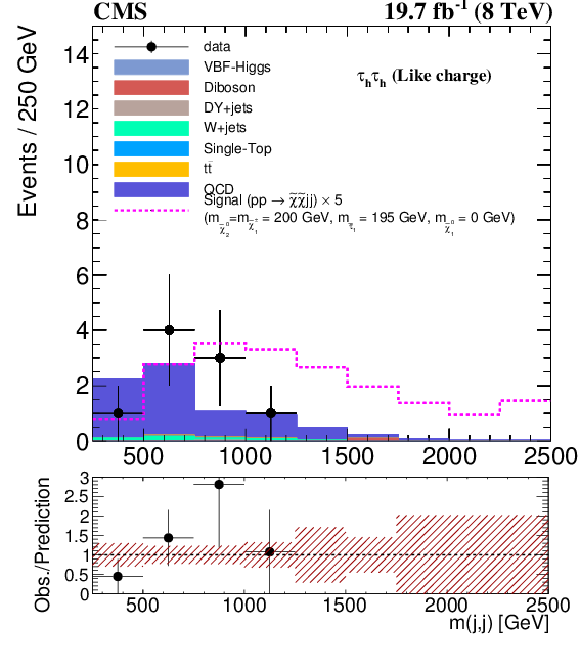
png pdf |
Figure 4-d:
Dijet invariant mass distributions in the (a) OS $\mu \tau _{ {\tau _\mathrm {h}} }$, (b) SS $\mu \tau _{ {\tau _\mathrm {h}} }$, (c) OS $\tau _{ {\tau _\mathrm {h}} }\tau _{ {\tau _\mathrm {h}} }$, and (d) SS $\tau _{ {\tau _\mathrm {h}} }\tau _{ {\tau _\mathrm {h}} }$ signal regions. The signal scenario with $m_{\tilde{ \chi }_2^0 }=m_{\tilde{ \chi }^{\pm}_1 }= $ 200 GeV , $m_{\tilde{ \tau }} = $ 195 GeV , and $m_{\tilde{\chi}^0_1 }= $ 0 GeV , as described in Section 4, is shown. The signal events are scaled up by a factor of 5 for purposes of visibility. The shaded band in the ratio plot includes the systematic and statistical uncertainties in the background prediction. |
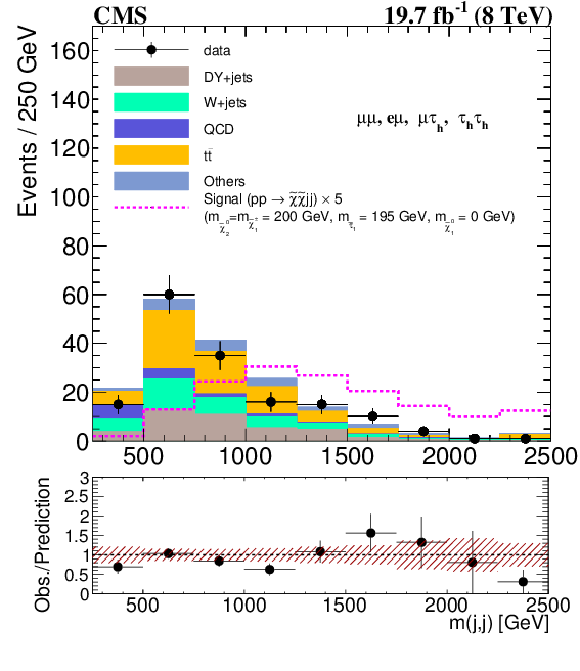
png pdf |
Figure 5:
Dijet invariant mass distribution for the combination of all search channels. The signal scenario with $m_{\tilde{ \chi }_2^0 }=m_{\tilde{ \chi }^{\pm}_1 }= $ 200 GeV , $m_{\tilde{ \tau }} = $ 195 GeV , and $m_{\tilde{\chi}^0_1 }= $ 0 GeV , as described in Section 4, is shown. The signal events are scaled up by a factor of 5 for purposes of visibility. The shaded band in the ratio plot includes the systematic and statistical uncertainties in the background prediction. |

png pdf |
Figure 6-a:
Combined 95% CL upper limits on the cross section as a function of $m_{\tilde{ \chi }_2^0 }=m_{\tilde{ \chi }^{\pm}_1 }$. The signal cross section is calculated with the VBF jet selection: jet ${p_{\mathrm {T}}} >$ 30 GeV , $ {| \Delta \eta (\text {jets}) | } > $ 4.2 , and $\eta _{\text {1}} \eta _{\text {2}} < $ 0 . (a) The results for the fixed-mass difference assumption, in which $m_{\tilde{ \chi }^{\pm}_1 } - m_{\tilde{ \tau }}= $ 5 GeV , for $m_{\tilde{ \chi }^{\pm}_1 } - m_{\tilde{\chi}^0_1 } = $ 50 GeV (compressed-mass spectrum) and $m_{\tilde{\chi}^0_1 } = $ 0 GeV (uncompressed-mass spectrum). (b) The corresponding results for the average-mass assumption, in which $m_{\tilde{ \tau }} = 0.5 m_{\tilde{ \chi }^{\pm}_1 } + 0.5 m_{\tilde{\chi}^0_1 }$. |
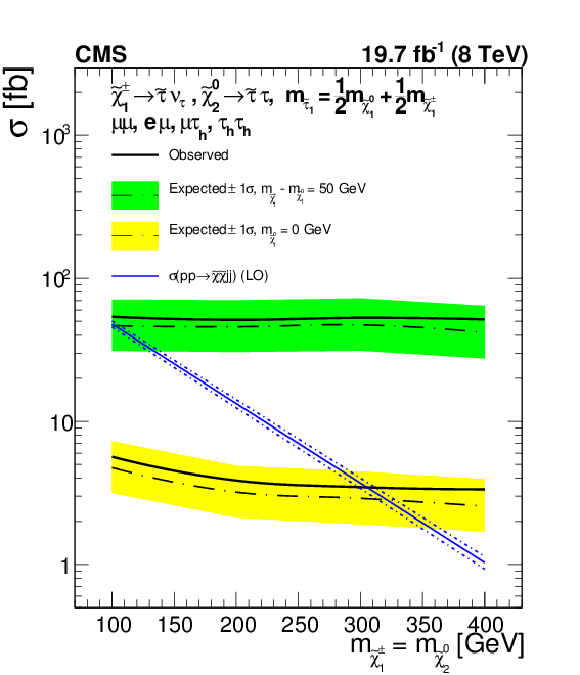
png pdf |
Figure 6-b:
Combined 95% CL upper limits on the cross section as a function of $m_{\tilde{ \chi }_2^0 }=m_{\tilde{ \chi }^{\pm}_1 }$. The signal cross section is calculated with the VBF jet selection: jet ${p_{\mathrm {T}}} >$ 30 GeV , $ {| \Delta \eta (\text {jets}) | } > $ 4.2 , and $\eta _{\text {1}} \eta _{\text {2}} < $ 0 . (a) The results for the fixed-mass difference assumption, in which $m_{\tilde{ \chi }^{\pm}_1 } - m_{\tilde{ \tau }}= $ 5 GeV , for $m_{\tilde{ \chi }^{\pm}_1 } - m_{\tilde{\chi}^0_1 } = $ 50 GeV (compressed-mass spectrum) and $m_{\tilde{\chi}^0_1 } = $ 0 GeV (uncompressed-mass spectrum). (b) The corresponding results for the average-mass assumption, in which $m_{\tilde{ \tau }} = 0.5 m_{\tilde{ \chi }^{\pm}_1 } + 0.5 m_{\tilde{\chi}^0_1 }$. |
| Tables | |

png pdf |
Table 1:
Summary of the event selection criteria for the different final states. The selections for the $\mu \mu jj$ and $\mathrm{ e } \mu jj$ channels are presented in one column ($\ell _{\mathrm{ e } /\mu } \mu jj$) as they are similar. The symbol $\ell _{\mathrm{ e } }$, $\mu $, ${\tau _\mathrm {h}} $ means that the lepton could be an electron, a muon, or a $ {\tau _\mathrm {h}} $ lepton. |

png pdf |
Table 2:
Number of observed events and corresponding background predictions for the OS channels. The uncertainties are statistical, including the statistical uncertainties from the control regions and simulated event samples. |
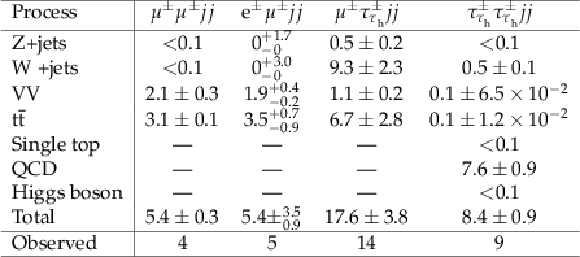
png pdf |
Table 3:
Number of observed events and corresponding background predictions for the SS channels. The uncertainties are statistical, including the statistical uncertainties from the control regions and simulated event samples. |

png pdf |
Table 4:
Cumulative signal event acceptance after application of the BF, central, and VBF requirements. Note that the jet ${p_{\mathrm {T}}}$ threshold for the $\mu \mu jj$ and $ {\tau _\mathrm {h}} {\tau _\mathrm {h}} jj$ final states is 30 GeV , while it is 50 GeV for the other final states. |

png pdf |
Table 5:
Signal event yields from simulation. The first terms $\{m_{\tilde{ \chi }^{\pm}_1 }, m_{\tilde{ \tau }} \}$ correspond to the fixed-mass difference assumption $\Delta m(\tilde{ \chi }^{\pm}_1 , \tilde{ \tau }) = $ 5 GeV , while the terms in parentheses ($\{m_{\tilde{ \chi }^{\pm}_1 }$, $m_{\tilde{ \tau }}\}$) correspond to the average-mass assumption $m_{\tilde{ \tau }} = 0.5m_{\tilde{\chi}^0_1 } + 0.5 m_{\tilde{ \chi }^{\pm}_1 }$. |
| Summary |
| A search is presented for non-coloured supersymmetric particles in the vector-boson fusion (VBF) topology using data corresponding to an integrated luminosity of 19.7 fb$^{-1}$ collected with the CMS detector in proton-proton collisions at $\sqrt{s}$ = 8 TeV. This is the first search for SUSY in the VBF topology. The search utilizes events in eight different final states covering both same- and opposite-sign dilepton pairs. The leptons considered are electrons, muons, and hadronically decaying $\tau$ leptons. The VBF topology requires two well-separated jets that appear in opposite hemispheres, with large invariant mass $m_{jj}$. The observed $m_{jj}$ distributions do not reveal any evidence for new physics. The results are used to exclude a range of $\tilde{ \chi }^{\pm}_1$ and $\tilde{ \chi }_2^0$ gaugino masses. For models in which the $\tilde{\chi}^0_1$ lightest-supersymmetric-particle mass is zero, and in which the $\tilde{ \chi }^{\pm}_1$ and $\tilde{ \chi }_2^0$ branching fractions to $\tau$ leptons are large, $\tilde{ \chi }^{\pm}_1$ and $\tilde{ \chi }_2^0$ masses up to 300 GeV are excluded at 95% CL. For a compressed-mass-spectrum scenario, in which $m_{\tilde{ \chi }^{\pm}_1} -m_{\tilde{\chi}^0_1} = $ 50 GeV, the corresponding limit is 170 GeV. While many previous studies at the LHC have focused on strongly coupled supersymmetric particles, including searches for charginos and neutralinos produced in gluino or squark decay chains, and a number of studies have presented limits on the Drell-Yan production of charginos and neutralinos, this analysis obtains the most stringent limits to date on the production of charginos and neutralinos decaying to $\tau$ leptons in compressed-mass-spectrum scenarios defined by the mass separation $\Delta m = m_{\tilde{ \chi }^{\pm}_1} - m_{\tilde{\chi}^0_1} < $ 50 GeV. |
| References | ||||
| 1 | P. Ramond | Dual Theory for Free Fermions | PRD 3 (1971) 2415 | |
| 2 | Y. A. Gol'fand and E. P. Likhtman | Extension of the algebra of Poincare group generators and violation of P invariance | JEPTL 13 (1971) 323 | |
| 3 | S. Ferrara and B. Zumino | Supergauge invariant Yang-Mills theories | Nucl. Phys. B 79 (1974) 413 | |
| 4 | J. Wess and B. Zumino | Supergauge transformations in four dimensions | Nucl. Phys. B 70 (1974) 39 | |
| 5 | A. H. Chamseddine, R. Arnowitt, and P. Nath | Locally Supersymmetric Grand Unification | PRL 49 (1982) 970 | |
| 6 | R. Barbieri, S. Ferrara, and C. A. Savoy | Gauge models with spontaneously broken local supersymmetry | PLB 119 (1982) 343 | |
| 7 | L. Hall, J. Lykken, and S. Weinberg | Supergravity as the messenger of supersymmetry breaking | PRD 27 (1983) 2359 | |
| 8 | CMS Collaboration | Search for new physics in the multijet and missing transverse momentum final state in proton-proton collisions at $ \sqrt{s} =$ 8 TeV | JHEP 06 (2014) 055 | CMS-SUS-13-012 1402.4770 |
| 9 | ATLAS Collaboration | Search for new phenomena in final states with large jet multiplicities and missing transverse momentum at $ \sqrt{s} =$ 8 TeV proton-proton collisions using the ATLAS experiment | JHEP 10 (2013) 130, [Erratum: 10.1007/JHEP01(2014)109] | 1308.1841 |
| 10 | CMS Collaboration | Search for new physics in events with same-sign dileptons and jets in pp collisions at $ \sqrt{s} =$ 8 TeV | JHEP 01 (2014) 163, [Erratum: 10.1007/JHEP01(2015)014] | CMS-SUS-13-013 1311.6736 |
| 11 | CMS Collaboration | Search for physics beyond the standard model in events with two leptons, jets, and missing transverse momentum in pp collisions at $ \sqrt{s} =$ 8 TeV | JHEP 04 (2015) 124 | CMS-SUS-14-014 1502.06031 |
| 12 | ATLAS Collaboration | Search for supersymmetry at $ \sqrt{s} =$ 8 TeV in final states with jets and two same-sign leptons or three leptons with the ATLAS detector | JHEP 06 (2014) 035 | 1404.2500 |
| 13 | ATLAS Collaboration | Search for supersymmetry in events containing a same-flavour opposite-sign dilepton pair, jets, and large missing transverse momentum in $ \sqrt{s} =$ 8 TeV pp collisions with the ATLAS detector | EPJC 75 (2015) 318 | 1503.03290 |
| 14 | ATLAS Collaboration | Search for squarks and gluinos with the ATLAS detector in final states with jets and missing transverse momentum using $ \sqrt{s} =$ 8 TeV proton-proton collision data | JHEP 09 (2014) 176 | 1405.7875 |
| 15 | CMS Collaboration | Searches for supersymmetry using the $ M_{T2} $ variable in hadronic events produced in pp collisions at 8 TeV | JHEP 05 (2015) 078 | CMS-SUS-13-019 1502.04358 |
| 16 | G. R. Farrar and P. Fayet | Phenomenology of the production, decay, and detection of new hadronic states associated with supersymmetry | PLB 76 (1978) 575 | |
| 17 | CMS Collaboration | Searches for electroweak production of charginos, neutralinos, and sleptons decaying to leptons and W, Z, and Higgs bosons in pp collisions at 8 TeV | EPJC 74 (2014) 3036 | CMS-SUS-13-006 1405.7570 |
| 18 | ATLAS Collaboration | Search for direct production of charginos and neutralinos in events with three leptons and missing transverse momentum in $ \sqrt{s} = $ 8 TeV pp collisions with the ATLAS detector | JHEP 04 (2014) 169 | 1402.7029 |
| 19 | B. Dutta et al. | Vector boson fusion processes as a probe of supersymmetric electroweak sectors at the LHC | PRD 87 (2013) 035029 | 1210.0964 |
| 20 | A. G. Delannoy et al. | Probing Dark Matter at the LHC Using Vector Boson Fusion Processes | PRL 111 (2013) 061801 | 1304.7779 |
| 21 | CMS Collaboration | Search for invisible decays of Higgs bosons in the vector boson fusion and associated ZH production modes | EPJC 74 (2014) 2980 | CMS-HIG-13-030 1404.1344 |
| 22 | CMS Collaboration | The CMS experiment at the CERN LHC | JINST 3 (2008) S08004 | CMS-00-001 |
| 23 | CMS Collaboration | Particle-Flow Event Reconstruction in CMS and Performance for Jets, Taus, and $ E_{\mathrm{T}}^{\text{miss}} $ | CDS | |
| 24 | CMS Collaboration | Commissioning of the Particle-flow Event Reconstruction with the first LHC collisions recorded in the CMS detector | CDS | |
| 25 | M. Cacciari, G. P. Salam, and G. Soyez | The anti-$ k_t $ jet clustering algorithm | JHEP 04 (2008) 063 | 0802.1189 |
| 26 | CMS Collaboration | Pileup Jet Identification | CMS-PAS-JME-13-005 | CMS-PAS-JME-13-005 |
| 27 | CMS Collaboration | Determination of jet energy calibration and transverse momentum resolution in CMS | JINST 6 (2011) 11002 | CMS-JME-10-011 1107.4277 |
| 28 | CMS Collaboration | Identification of b-quark jets with the CMS experiment | JINST 8 (2013) P04013 | CMS-BTV-12-001 1211.4462 |
| 29 | CMS Collaboration | Performance of b tagging at $ \sqrt{s}=$ 8 TeV in multijet, $ \rm{t}\overline{\rm t} $ and boosted topology events | CMS-PAS-BTV-13-001 | CMS-PAS-BTV-13-001 |
| 30 | CMS Collaboration | The performance of the CMS muon detector in proton-proton collisions at $ \sqrt{s} $ = 7 TeV at the LHC | JINST 8 (2013) P11002 | CMS-MUO-11-001 1306.6905 |
| 31 | CMS Collaboration | Performance of electron reconstruction and selection with the CMS detector in proton-proton collisions at $ \sqrt{s} =$ 8 TeV | JINST 10 (2015) P06005 | CMS-EGM-13-001 1502.02701 |
| 32 | CMS Collaboration | Performance of $ \tau $-lepton reconstruction and identification in CMS | JINST 7 (2012) P01001 | |
| 33 | J. Alwall et al. | MadGraph 5: going beyond | JHEP 06 (2011) 128 | 1106.0522 |
| 34 | S. Frixione, P. Nason, and C. Oleari | Matching NLO QCD computations with parton shower simulations: the POWHEG method | JHEP 11 (2007) 070 | 0709.2092 |
| 35 | M. Czakon, P. Fiedler, and A. Mitov | Total Top-Quark Pair-Production Cross Section at Hadron Colliders Through $ O(\alpha_s^4) $ | PRL 110 (2013) 252004 | 1303.6254 |
| 36 | N. Kidonakis | Next-to-next-to-leading logarithm resummation for $ \textit{s} $-channel single top quark production | PRD 81 (2010) 054028 | 1001.5034 |
| 37 | R. Gavin, Y. Li, F. Petriello, and S. Quackenbush | FEWZ 2.0: A code for hadronic Z production at next-to-next-to-leading order | CPC 182 (2011) 2388 | 1011.3540 |
| 38 | J. M. Campbell and R. K. Ellis | MCFM for the Tevatron and the LHC | NPPS 205-206 (2010) 10 | 1007.3492 |
| 39 | K. Arnold et al. | VBFNLO: A parton level Monte Carlo for processes with electroweak bosons | CPC 180 (2009) 1661 | 0811.4559 |
| 40 | J. Pumplin et al. | New generation of parton distributions with uncertainties from global QCD analysis | JHEP 07 (2002) 012 | hep-ph/0201195 |
| 41 | P. M. Nadolsky et al. | Implications of CTEQ global analysis for collider observables | PRD 78 (2008) 013004 | 0802.0007 |
| 42 | T. Sj\"ostrand, S. Mrenna, and P. Z. Skands | PYTHIA 6.4 physics and manual | JHEP 05 (2006) 026 | hep-ph/0603175 |
| 43 | N. Davidson, G. Nanava, and Z. W. T. Przedzi\'nski, E. Richter-W\cas | Universal Interface of TAUOLA Technical and Physics Documentation | CPC 183 (2012) 821 | 1002.0543 |
| 44 | GEANT4 Collaboration | GEANT4---a simulation toolkit | NIMA 506 (2003) 250 | |
| 45 | S. Abdullin et al. | The fast simulation of the CMS detector at LHC | J. Phys. Conf. Ser. 331 (2011) 032049 | |
| 46 | CMS Collaboration | Measurement of the inclusive Z cross section via decays to tau pairs in pp collisions at $ \sqrt{s} =$ 7 TeV | JHEP 08 (2011) 117 | |
| 47 | CMS Collaboration | CMS Luminosity Based on Pixel Cluster Counting - Summer 2013 Update | CMS-PAS-LUM-13-001 | CMS-PAS-LUM-13-001 |
| 48 | S. Alekhin et al. | The PDF4LHC Working Group Interim Report | 1101.0536 | |
| 49 | M. Botje et al. | The PDF4LHC Working Group Interim Recommendations | 1101.0538 | |
| 50 | A. D. Martin, W. J. Stirling, R. S. Thorne, and G. Watt | Update of parton distributions at NNLO | PLB 652 (2007) 292 | 0706.0459 |
| 51 | M. Ubiali | NNPDF1.0 parton set for the LHC | NPPS 186 (2009) 62 | 0809.3716 |
| 52 | A. L. Read | Presentation of search results: the $ CL_{s} $ technique | JPG 28 (2002) 2693 | |
| 53 | T. Junk | Confidence level computation for combining searches with small statistics | NIMA 434 (1999) 435 | |
| 54 | G. Cowan, K. Cranmer, E. Gross, and O. Vitells | Asymptotic formulae for likelihood-based tests of new physics | EPJC 71 (2011) 1554, [Erratum: 10.1140/epjc/s10052-013-2501-z] | 1007.1727 |

|
Compact Muon Solenoid LHC, CERN |

|

|

|

|

|

|